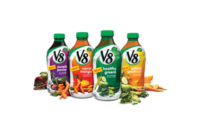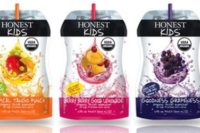Race and Fruit Juice
African-American and Latino children may be replacing soda with 100% fruit juice while their white peers are not, according to a new study.

The study was the first to compare trends of sugar-sweetened beverages and 100% juice consumption in California.
“The decrease in the consumption of sugar-sweetened beverages among kids is a promising public health trend,” said Amy Beck, MD, MPH, lead author and pediatrician at UCSF Benioff Children’s Hospital and San Francisco General Hospital and Trauma Center. “But it is concerning that minority children are increasing their consumption of 100% fruit juice, which often has just as much sugar as soda.”
Researchers examined data from the California Health Interview Survey, a telephone survey conducted every two years from 2003 to 2009, which asked parents how many servings of sugar-sweetened beverages and 100 percent fruit juice their children, ages 2-11, consumed the day before.
“Parents who are thinking actively about nutrition wouldn’t give their kids Coca-Cola, but might give apple juice,” said Beck. “But 8oz. of Coca Cola contains 27g of sugar, as does 8oz. of apple juice. We need to make sure parents understand the best thing to replace soda is water or milk.”
The results are published in the June/July issue of journal of Academic Pediatrics.
Mixed Messages About Juice
The researchers found that sugar-sweetened beverage consumption among all ethnicities decreased from 40% in 2003 to 16% in 2009 among children ages 2 to 5. Among children 6 to 10, it also decreased from 54% in 2003 to 33% in 2009. However, there were higher rates of consumption amongst Latinos, African-Americans and children of parents with lower levels of education.
For kids ages 2 to 5, the consumption of two or more servings of 100 percent fruit juice per day decreased among white children and increased among Latinos. For kids ages 6 to 11, their consumption of two or more servings remained stable for white children and increased among Latinos and African-Americans.
“Our results stress the need for more education on healthy beverages and making sure these messages reach all ethnic groups,” said Beck. “It’s crucial that the public health message reflect that 100 percent fruit juice should be limited, and not used as a substitute for soda.”
Over the past decade, California has passed legislation to ban sugar-sweetened beverage sales in schools and implemented public health campaigns focused on reducing soda consumption by children. However, fewer efforts have targeted reducing the amount of juice children are drinking.
“There has been a lot of focus in California on reducing the consumption of sugar-sweetened beverages, and that appears to be working,” said Beck. “However, parents are getting mixed messages about juice, and some parents appear to be using it as a replacement for the sugar-sweetened beverages, rather than turning to water or milk.”
Changes Needed to Public Health Message
The American Academy of Pediatrics recommends that children age 6 and younger consume a maximum of 4-6oz.of fruit juice per day, and that children ages 7 and older consume no more than 12oz. per day.
The public health message being sent to parents is that 100% fruit juice is OK, according to the researchers, due much in part to juice’s distribution through federal programs.
Fruit juice is available in schools through the National School Lunch Program, which provided low-cost or free lunches to more than 31 million children nationally each school day in 2011. Juice also is distributed to parents through the Women, Infants and Children (WIC) program, a federal grant program for low-income, nutritionally at-risk women and children up to age 5 and through the Child Care Food Program.
“We want to see kids drinking fewer beverages that give them unnecessary calories – including fruit juice,” said senior author Kristine Madsen, MD, MPH, of the Division of Community Health and Human Development at UC Berkeley. “We don’t want them replacing soda with juice. It’s better to eat the fruit – not drink the fruit juice.”
The study’s other authors include Anisha Patel, MD, MSPH, a pediatrician at the UCSF Benioff Children’s Hospital. The authors have no conflicts of interest or financial disclosures.
The study was funded by a grant from the National Center for Advancing Translational Sciences, National Institute of Health.
Looking for a reprint of this article?
From high-res PDFs to custom plaques, order your copy today!





